Can Dogs’ Paws Actually Freeze? Here’s What Every Dog Parent Should Know This Winter.
When you purchase through links on our site, we may earn a commission. Here’s how it works.
The first time you watch your dog lift a paw in the snow, it hits you with that mix of concern and instant guilt: Is this too cold for them? They’re eager to explore, nose buried in powder, tail doing its happy metronome thing… yet that tiny paw-lift says something’s going on down there.
Table of Contents
Most dog parents assume paws work like our bare feet, and cold ground equals cold paws. But here’s where things get interesting: researchers discovered something inside dog paws that doesn’t quite follow human logic. And it changes the whole conversation about what “too cold” really means.
Before we get to that twist, let’s walk through what your dog actually experiences on chilly ground, when the risks start creeping in, and how to tell the difference between harmless discomfort and “okay, time to get inside.”
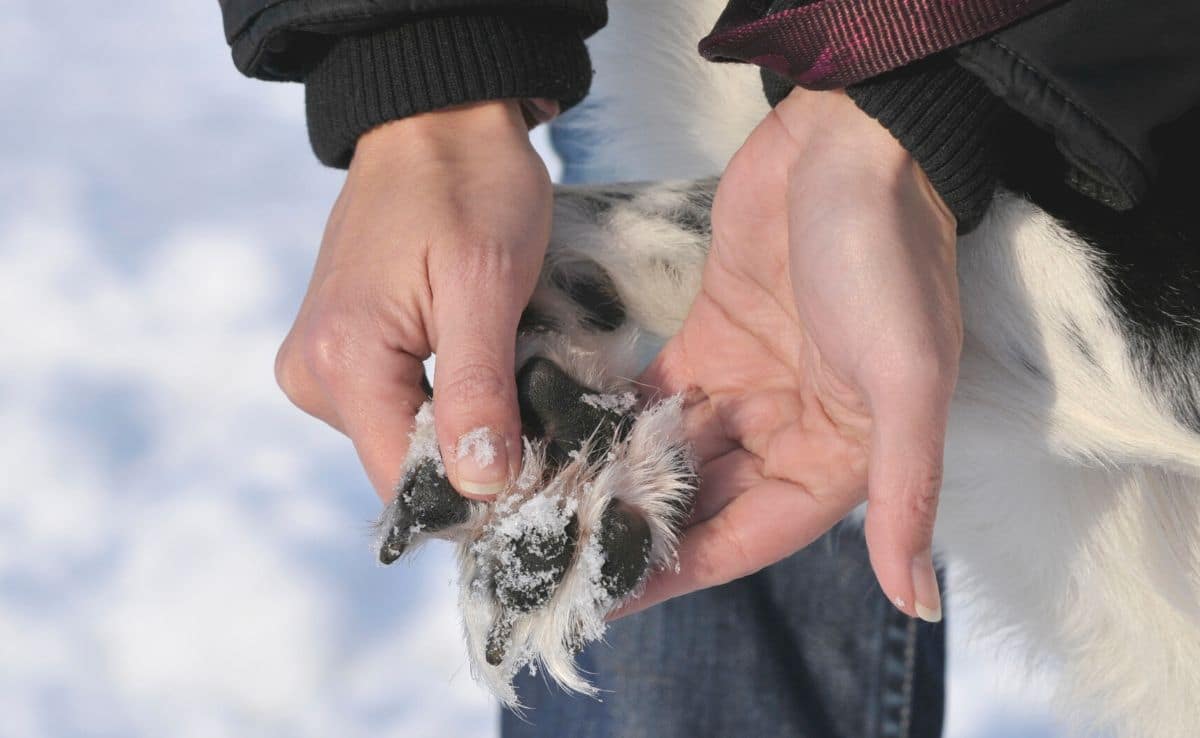
Your dog’s paws can handle more than you think… but they also have limits most owners never realize until winter sends a sharp reminder.
Let’s break it all down.
Can Dog Paws Freeze? (Quick Answer)
Short answer: yes, but not the way you might think.
Dog paws can get cold, hurt, and even develop frostbite in harsh conditions. But here’s the twist most owners don’t expect: dogs have a built-in system in their paws that gives them more cold resistance than human skin. It won’t make them invincible, though, especially when temperatures drop fast or the ground is wet, salty, or icy.
So while paws can freeze under the wrong circumstances, the real story lies in why they stay warm longer than you’d imagine… and what finally pushes them past their limit.
And that’s when the science gets surprisingly interesting.
The Research: A Specialized Circulation System Hidden Inside Dog Paws
For years, veterinary researchers have questioned how dogs tolerate cold ground so well when their paws appear relatively unprotected. Early studies suggested that dogs could withstand temperatures as low as -35°C; however, most of that work focused on older breeds or working dogs in extreme climates.
To test whether those findings applied to modern domesticated dogs, Dr. Hiroyoshi Ninomiya and a research team at Yamazaki Gakuen University in Tokyo conducted a detailed investigation. Their study, published in the Wiley Online Library, used electron microscopy to examine the internal structures of domesticated dogs’ paw pads.
The team confirmed that dogs possess a specialized vascular adaptation known as a counter-current heat exchange system.
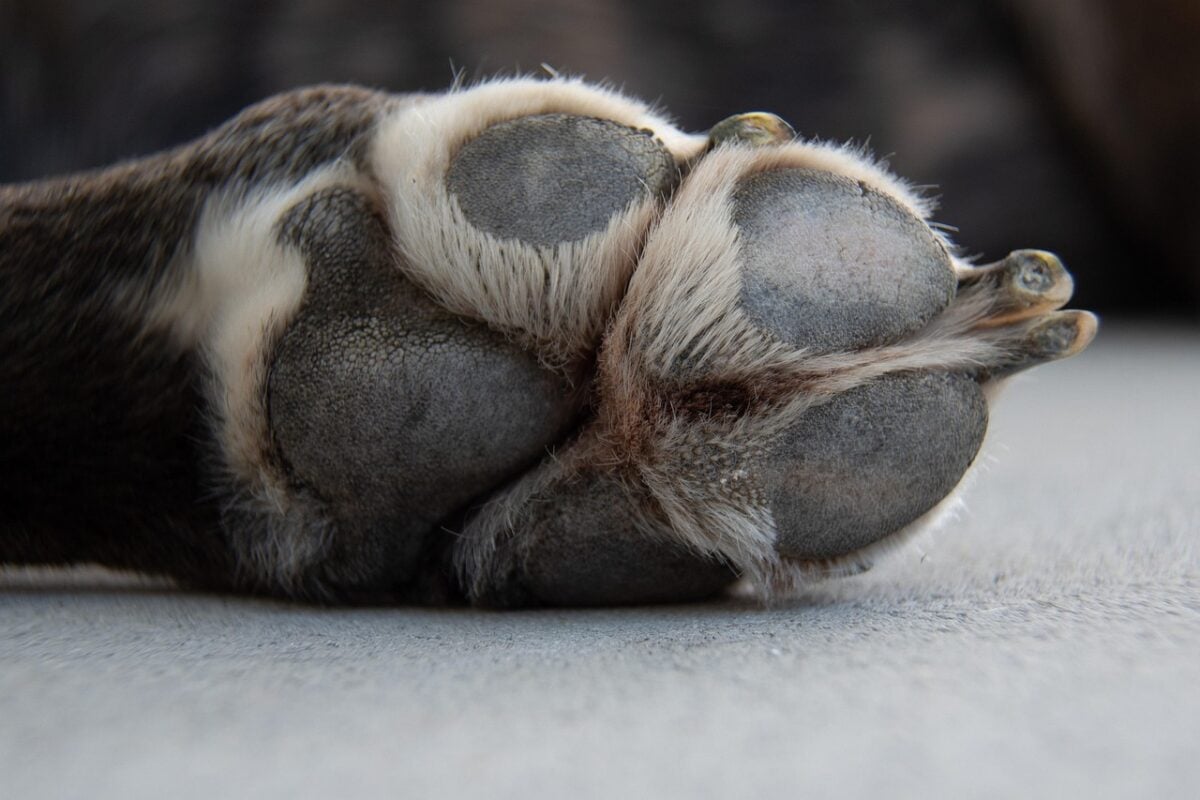
How This Circulatory System Works
Inside each paw pad, arteries carrying warm blood from the heart run extremely close to veins returning cool blood from the paw. As cold temperatures affect the paw pad, heat naturally transfers from the warm arterial blood into the cooler venous blood nearby.
This process warms the returning blood before it re-enters the dog’s core and simultaneously delivers warmer blood back to the paw. The result is a natural heat recycling loop that helps delay freezing in cold weather.
This adaptation is observed in some cold-adapted species, such as penguins and dolphins, but has not been previously identified in domesticated mammals. Researchers believe this system likely developed during early canine evolution when survival in harsh climates required an efficient method of protecting extremities.
Do Dog Paws Still Get Cold?
Yes. The system delays freezing but does not eliminate risk. Dogs can still experience discomfort, cold sensitivity, and even frostbite in severe or prolonged conditions.
The research simply helps explain why dogs can tolerate cold surfaces longer than many owners expect and why understanding the limits of this adaptation is essential for winter safety.
Where This Adaptation Reaches Its Limit
The counter-current heat exchange system inside a dog’s paw is impressive, but it is not unlimited. Under certain conditions, dogs lose heat faster than their bodies can replace it, which puts their paws at risk of cold-related injury.
- Wet surfaces increase heat loss: Snow, slush, or ice melt between the toes accelerates cooling and can cause rapid paw lifting or sensitivity.
- Thin-coated or small breeds cool faster: Dogs with short coats, hairless breeds, seniors, and dogs with medical issues lose core heat more quickly, which reduces warm blood flow to the paws.
- Puppies and senior dogs have reduced tolerance: Puppies have developing circulation and small paw pads, while older dogs often experience slower blood flow, making both groups more vulnerable.
- Salt and chemicals cause irritation: Deicers and rough ice can create small abrasions that sting or burn once the cold hits exposed tissue, leading to paw lifting, licking, or refusal to walk.
- Extreme cold still overwhelms the system: At very low temperatures, incoming blood is simply not warm enough to counter heat loss, increasing the risk of frostbite.
- Prolonged exposure compounds heat loss: Even dogs that start out comfortable can become cold as the walk continues, especially if temperatures are below freezing.
The Bottom Line
Dogs have a remarkable evolutionary adaptation that delays freezing in their paws, but this system has clear limits. Cold, wet, windy, salty, or subfreezing conditions can override the natural warming mechanism.
Understanding these limits helps owners protect their dogs from discomfort and potential cold-related injuries. The video below helps shed more light on why dog paws don’t freeze.
What Cold Actually Feels Like for Dogs
Dogs handle chilly ground better than humans, but that does not mean they experience cold the same way. Paw pads contain nerve endings similar to human skin, so when temperatures drop, dogs feel those sharp, icy sensations immediately. Moisture amplifies the cold, and thin pads or small paws lose heat faster than larger, thicker ones.
Some dogs barely react. Others lift a foot the moment it touches frosty pavement. It depends on surface temperature, paw thickness, and how effectively their circulation can keep the area warm. Understanding these sensations helps you recognize discomfort long before it becomes a problem.
5 Signs Your Dog’s Paws Are Too Cold
Dogs show several clear behavioral and physical cues when their paws become uncomfortably cold. Paying attention to these early signs helps prevent irritation, injury, or the risk of frostbite in harsher conditions.
- Paw lifting or “dancing”: One of the earliest signs of discomfort is when a dog lifts a paw repeatedly or alternates feet to keep them off the ground.
- Hesitation or slowing down: A dog that suddenly walks more slowly, stops frequently, or tries to turn back may be signaling that the ground is too cold.
- Limping or refusing to bear weight: Cold surfaces can make the pads feel sharp or painful, causing a dog to avoid placing pressure on certain paws.
- Excessive licking during or after the walk: Dogs often lick their paws to warm them or soothe irritation from ice, snow, or chemicals.
- Redness or irritation: After a walk, check the pads and skin between the toes for flushed skin, abrasions, or small ice pellets stuck between the pads.
Frostbite Warning Signs
Frostbite occurs when tissue becomes so cold that blood flow to the area is reduced. Paws are especially vulnerable in severe weather, wet conditions, and prolonged exposure to cold temperatures.
According to the American Veterinary Medical Association (AVMA) guidelines, frostbite is a severe risk in extreme cold, even for pets that seem fine, and the risk isn’t just the pad itself but the tissue beneath.
Watch for the following indicators:
- Pale or grayish paw pads: Early frostbite may appear as whitening or bluing of the pad surface.
- Cold, firm, or waxy-feeling pads: The tissue may feel unusually stiff or hard to the touch.
- Pain when touched: Dogs may pull the paw away or vocalize when the area is handled.
- Swelling after warming: As circulation returns, the affected area may appear puffy or sensitive.
- Blisters or darkened skin: These signs indicate more advanced frostbite and require immediate veterinary attention.
If you notice any of these signs, bring your dog indoors and assess their paws carefully. Prompt action helps prevent more serious cold-related injuries.
When to Call a Veterinarian
Most cold paws recover quickly once your dog is indoors and warmed gradually, but some situations need professional attention.

If the pads remain discolored after warming, if your dog continues to limp or avoid putting weight on the paw, or if blisters, sores, or swelling appear, contact a veterinarian. Persistent pain or sensitivity is also a sign that deeper tissue may be affected. Early care helps prevent complications and supports healthy healing.
Common Paw Problems Made Worse by Cold Weather
Cold weather can intensify existing paw issues. Dry air and frozen surfaces worsen cracked pads, and mild allergies may flare when the skin becomes irritated by ice, salt, or chemical deicers. Dogs prone to interdigital cysts or yeast infections often lick their paws more frequently after cold walks, which can further irritate the skin.
Even minor redness or roughness that seems harmless in warmer months can become painful once cold air and moisture are added. Winter conditions tend to highlight every small vulnerability, so knowing your dog’s paw history helps you anticipate potential problems.
Breed, Age, and Coat Factors That Affect Cold Tolerance
Not all dogs handle cold weather equally. Northern breeds like Huskies and Malamutes were built for freezing temperatures, with thick coats, sturdy paw pads, and strong circulation. Breeds with thin coats or small frames, such as Chihuahuas, Greyhounds, Whippets, Italian Greyhounds, and many toy breeds, lose heat quickly and reach discomfort much sooner.
Age is another important factor. Puppies have developing circulation and softer paw pads, while senior dogs often experience slower blood flow and increased joint sensitivity. Even if two dogs walk the same route, one may be perfectly comfortable while the other is quietly signaling that the cold is too much.
How Cold Is Too Cold for Dog Paws?
You know how we humans step outside in winter, feel the wind slap us across the face, and instantly regret our life choices? Dogs don’t always give us that luxury; they’ll happily trot into an arctic tundra like it’s Tuesday.
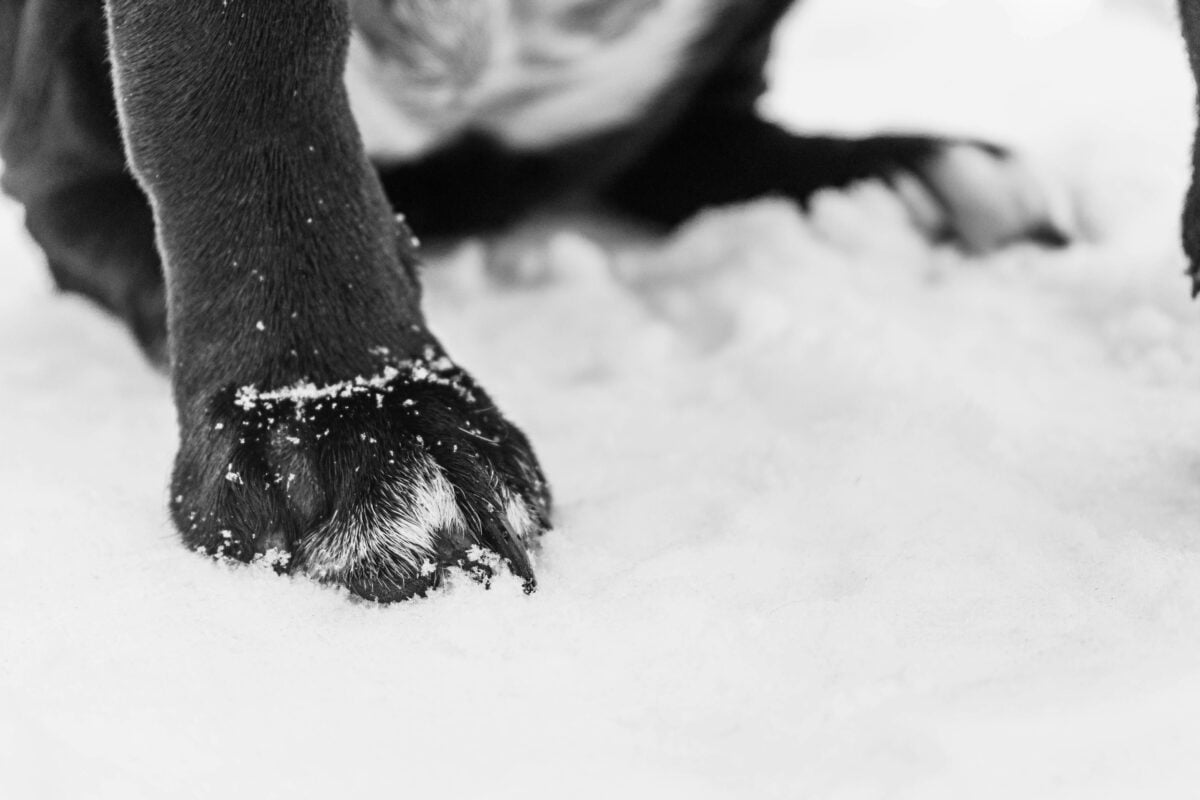
When temperatures drop, your dog’s paws don’t instantly freeze, but they do hit certain thresholds where cold goes from uncomfortable to risky to dangerous.
40–32°F (4.4–0°C): Mild Risk
Most dogs can tolerate this range for short periods, but cold pavement and wet surfaces can start to bother smaller breeds, short-haired dogs, dogs with naturally thin paw pads, seniors, and puppies. Salt and ice-melt chemicals are already active at these temperatures and can irritate paws even before severe cold sets in.
What to do: Shorten walks, consider applying a paw balm as a protective barrier, and wipe paws after returning indoors.
32–20°F (0 to –6.6°C): Moderate Risk
This is where true cold stress begins. Paw pads lose heat quickly, and exposure to salt can lead to cracking or chemical burns. Dogs often start doing the familiar paw-lift or quick-step walk, signaling that they are in discomfort. Even typically cold-tolerant breeds may react in icy or windy conditions.
What to do: Use boots or paw balm, keep walks brisk, and watch for shivering, limping, or hesitation.
20–0°F (–6.6 to –17.8°C): High Risk
At this point, all dogs are vulnerable to frostbite and hypothermia. The AVMA notes that paws, ears, and tails are among the first body parts to freeze. USDA temperature guidelines emphasize that dogs should not be exposed to prolonged cold without proper shelter, underscoring the harshness of these conditions. Once paws reach subfreezing temperatures, the body’s natural warming mechanisms are unable to keep up.
What to do: Keep outdoor time short, use protective gear such as boots, and monitor closely for warning signs, including persistent paw-lifting, whining, or changes in paw pad color.
Below 0°F (–17.8°C): Extreme Risk
Cold at this level becomes dangerous very quickly. Frostbite can occur within minutes on unprotected paws, and even thick-coated or northern breeds are at risk. Ice accumulation between toes can cause cuts or microtears, and wind chill significantly increases the threat.
What to do: Limit outdoor exposure to very brief potty breaks and ensure paws are fully protected with appropriate winter gear.
Cold Temperature Risk Levels for Dog Paws
To make these temperature ranges even easier to reference, here’s a quick infographic that breaks down the risk levels and what to do at each stage.
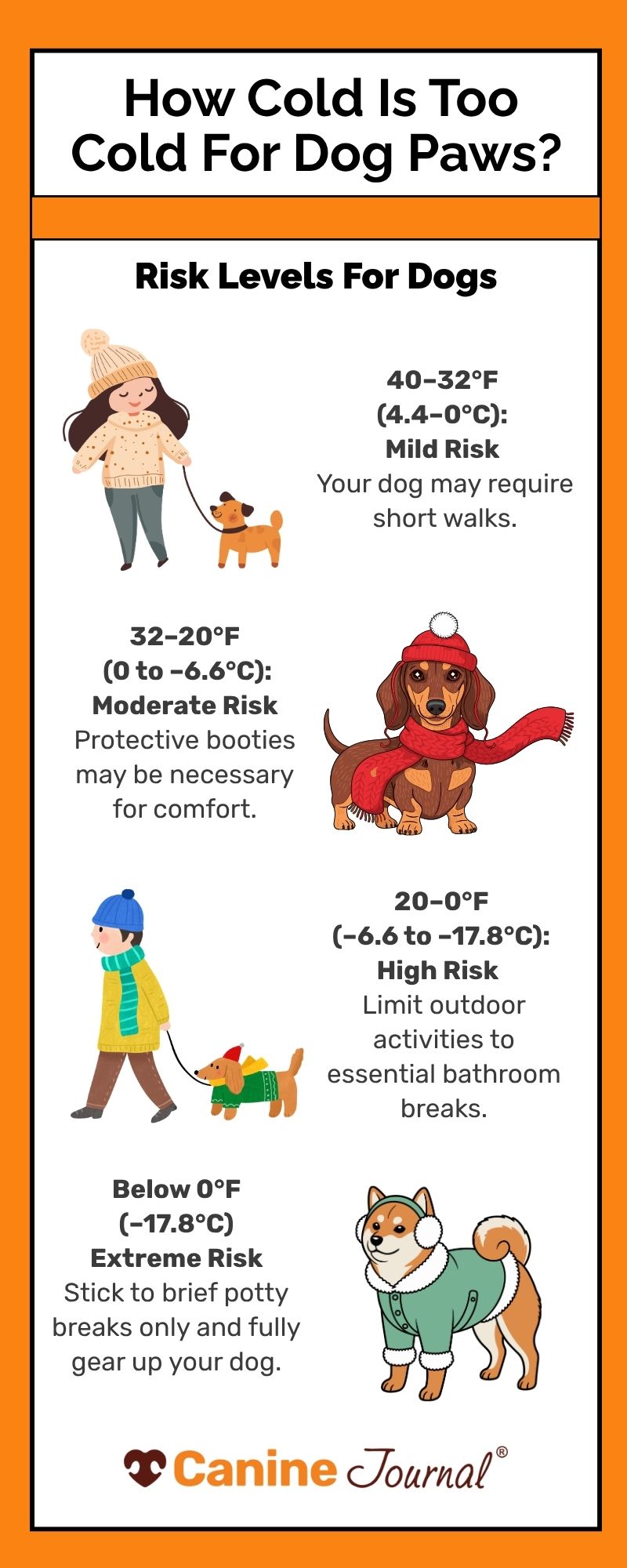
If you are wondering how these temperature ranges apply to your dog as a whole, not just their paws, our detailed guide on cold tolerance covers breed differences, safe outdoor time, and when winter becomes dangerous. Take a look here: How Cold Is Too Cold for a Dog?
Temperature Isn’t the Only Threat
Cold isn’t the only factor that puts your dog’s paws at risk. Even when the air temperature seems safe, several environmental conditions can make the ground much harsher on paw pads:
- Chemical de-icers that can burn skin and cause toxicity if licked
- Sharp ice or compacted snow that can cut or abrade paw pads
- Frozen or uneven surfaces that create micro-tears with repeated contact
- Moisture that speeds up heat loss and leaves paws vulnerable to injury
- Windchill, which lowers the effective temperature your dog actually feels
According to Tufts University’s weather-safety scale, real cold-weather risk comes from a combination of temperature, wind, moisture, and your dog’s coat type, not temperature alone.
How to Warm Cold Paws Safely
When your dog’s paws become uncomfortably cold, the safest approach is to warm them slowly and gently. Start by bringing your dog indoors and settling them in a warm, dry area. A soft towel works well for the first stage. Wrap the towel around each paw and hold it in place for a moment to absorb moisture and begin restoring warmth.
If the paws feel very cold, a brief soak in warm water can help. Use a shallow bowl of lukewarm water and keep each paw submerged for a minute or two. This method warms the tissue gradually and encourages healthy circulation without risking burns.

Once finished, dry the paws carefully, including the spaces between the toes, since lingering moisture leads to faster heat loss once your dog goes back outside.
A paw balm or moisturizer can soothe irritated pads and restore flexibility to the skin, especially if the cold has caused dryness. What you want to avoid are direct heat sources. Hair dryers, heating pads, and hot air vents may seem convenient, but they can damage sensitive tissue and worsen frostbite if it has begun to develop.
After warming, keep an eye on your dog for any lingering signs of discomfort. Continued limping, discoloration of the pads, or sensitivity to touch may indicate a more serious issue, and a veterinarian should be consulted if symptoms persist.
7 Winter Paw Protection Tips
A few simple habits can go a long way in keeping your dog’s paws comfortable and protected during cold weather. These key steps help reduce irritation, cracking, and cold-related discomfort.
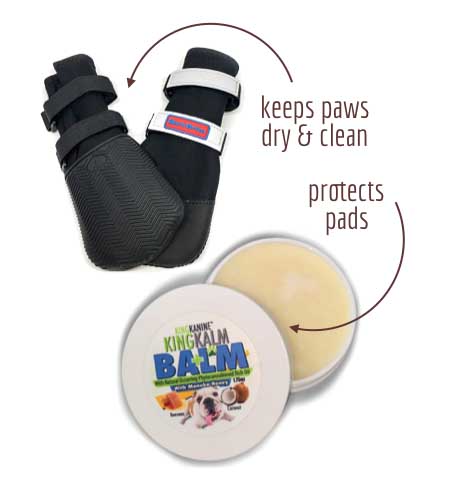
- Use protective booties: High-quality booties such as Bark Brite Neoprene Paw Protector Dog Boots. shield paws from cold surfaces, ice, and deicing chemicals when worn consistently. They’re water-resistant and have good traction.
- Apply paw balm before walks: A thin layer of balm, such as King Kanine’s Dog Paw Balm with CBD, creates a barrier that helps prevent dryness, cracking, and irritation.
- Trim excess fur around the toes: Shorter fur reduces ice and snow buildup between the pads.
- Rinse and dry paws after outings: Removing salt and debris helps prevent irritation and keeps pads healthy.
- Avoid heavily salted areas: Choose cleaner paths or grassy edges when possible to reduce exposure to harsh chemicals.
- Shorten walks in extreme cold: Frequent, shorter trips help minimize prolonged exposure to freezing surfaces.
- Check paws regularly: Look for redness, lodged ice, or early signs of discomfort so you can act quickly.
Incorporating these steps makes winter outings safer and more comfortable for your dog, even on cold or icy days.
Tip: If you’re not using boots, be sure to wipe off your dog’s paws after going on a walk to remove any ice, salt, or other residues he may have picked up.
Preventing Snowballs Between the Toes
Snowballs form when snow clings to the fur between a dog’s toes and packs into icy clumps that feel like walking on small stones. Long-haired dogs are especially prone to this, but any dog with fluffier feet may experience it.
Trimming the fur around and between the toes can significantly reduce snow buildup. Applying a thin layer of paw balm before heading outside creates a barrier that helps repel snow. After the walk, check between the toes and remove any clumps before they harden.
These simple steps keep your dog more comfortable during winter outings.
Safe Winter Exercise Tips
When temperatures drop, adjusting your dog’s routine can help keep them safer and more comfortable. Shorter, more frequent walks are often better than a single long outing, especially when wind or moisture make conditions harsher.
Choosing routes with cleared sidewalks or softer snow also minimizes direct contact with frozen surfaces.
- Opt for shorter walks during cold spells.
- Choose paths that avoid salted or icy pavement.
- Keep an eye on pacing and paw lifting during walks.
- Pause frequently to check paws for ice buildup.
Let your dog set the pace. Slowing down, lifting paws, or wanting to head home are clear signals that the ground is becoming too cold.
On very cold days, indoor play sessions, puzzle toys, and short training games can provide exercise without exposing your dog to harsh conditions.
If you enjoy watching dogs embrace winter, this next video is full of pure snow-day energy. It is a fun reminder of how much joy a fresh layer of snow can bring.
Your Cold Dog Paw Questions Answered
Cold weather brings up a lot of concerns for dog owners, and every dog handles winter a little differently. Below are some of the most common questions we hear about paw safety in cold conditions. If you have a question that is not covered here, feel free to ask in the comments, and we will help you find the right answer.
How do I know if the ground is too cold for my dog?
A quick way to judge surface temperature is to press the back of your hand to the ground for several seconds. If it feels uncomfortably cold to you, it will likely be too cold for your dog’s paws as well. Watch for paw lifting, slowing down, or hesitation during the walk.
How long can a dog walk in cold weather?
It depends on factors such as temperature, breed, size, and surface conditions. Many dogs tolerate 10 to 20 minutes in mild cold, but shorter outings are safer as temperatures drop.
Should dogs wear booties in winter?
Booties provide excellent protection on icy, salted, or extremely cold surfaces. Dogs who are new to wearing them may need a short adjustment period.
Why does my dog chew or lick their paws after cold walks?
Licking is often a response to irritation from cold, ice, salt, or chemical deicers. It can also signal tiny abrasions or dryness from frozen surfaces. Rinsing and drying paws after winter walks helps prevent irritation and reduces excessive licking.
Do paw balms really help?
Yes. Paw balms form a protective layer against snow, salt, and moisture, helping keep pads flexible and less prone to cracking.
If you need a smile after all this cold-weather talk, here is another quick video of dogs absolutely loving their time in the snow. It is a good reminder that, with the right precautions, winter can be a blast for our pups.
Keeping Your Dog Comfortable in Cold Weather
Even though a dog’s paws have incredible natural protection, there is still a limit to what they can handle. No dog should be left outside in freezing temperatures, and small breeds or thin-coated dogs are especially vulnerable to heat loss. Insulation, supervision, and shorter outings make a big difference when the weather turns harsh.
Once temperatures drop below 20°F, all dogs become more susceptible to frostbite and hypothermia, regardless of size or coat type. Proper gear, safe walking routines, and monitoring for early signs of discomfort help keep winter outings both enjoyable and safe. If you need ideas for protective gear, our guides to the best dog boots and winter coats are a great place to start. And if you live in a warm climate, watch for hot pavement in summer, which can pose risks of its own.
Tell Us Your Dog’s Cold-Weather Paw Story
Every dog reacts to winter differently, and your experience could help another pet parent. Have you found a great pair of booties? Does your dog lift their paws at the first sign of frost? Share your story or questions in the comments below.



